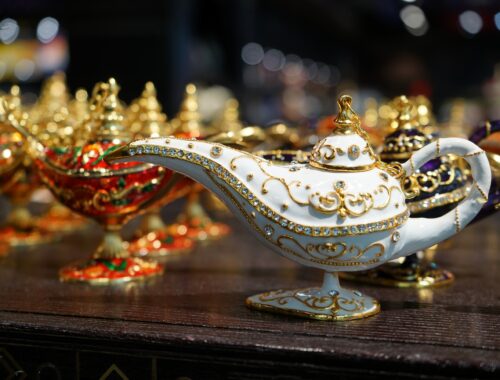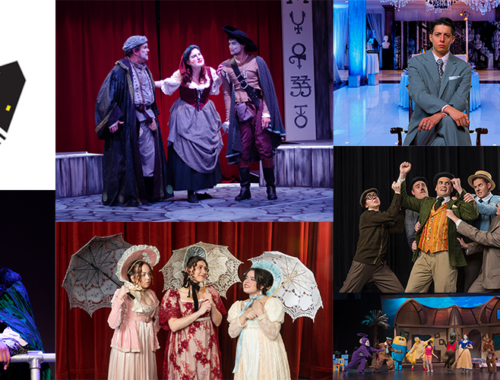
Emilia Bassano Lanier – Historical Research
Timeline of Emilia Bassano Lanier’s life
1569 Likely year of Aemilia Bassano’s birth in London. She is christened Aemilia Baptist Bassano at St. Botolph in Bishopsgate on 27 January, 1569 as the child of Margaret (Johnson) Bassano, who was English, and Baptista Bassano, an Italian musician at court who may have been of Jewish descent.
1576 11 April: Aemilia’s father, Baptista Bassano dies. Margaret Johnson (1554?–1587) and Baptista Bassano (1515/20?–1576). By Janey Bartholomew. Baptista Bassano was one of six sons born to Jeronimo Bassano. The Bassano family were court musicians and instrument makers who immigrated to England from Venice in the 1530s to play in the court of King Henry VIII. Little is known about Margaret Johnson, with whom Baptista had two children, Aemilia and Angela. Baptista’s will dated 1576 describes Margaret as his ‘reputed wife’ to whom he leaves the leases for three houses in St. Botolph, Bishopsgate, where the family resided. Both Margaret and Baptista were buried at St. Botolph’s, Bishopsgate, just outside of London.
Late 1570s–mid-1580s Aemilia receives an extensive humanist education while residing in the home of Susan Wingfield, later Susan Bertie, Countess of Kent.
1585 Henry Carey, 1st Baron Hunsdon (b. 4 March 1526–d. 23 July 1596), assumed the prestigious and influential position of Lord Chamberlain in the court of Queen Elizabeth I.
1587 June or July: Aemilia’s mother, Margaret (Johnson) Bassano, dies; she is buried on 7 July in Bishopsgate, London. Possible year in which Lanyer, at around 18, becomes mistress of Lord Chamberlain Hunsdon, Henry Carey.
1590 First iteration of a company of actors called the Lord Chamberlain’s Men, with Henry Carey as patron.
1592–1594 London theatres are shut down as a result of the Bubonic Plague.
1592 18 October: Having been arranged by Henry Carey, Lanyer, then pregnant by Carey, marries Alphonso Lanyer at St. Botolph’s Aldgate.
1593 Lanyer gives birth to a son, Henry, possibly named after his biological father, Henry Carey.
1594 Second, post-Bubonic Plague iteration of the Lord Chamberlain’s Men, with Henry Carey as patron.
1596 23 July: Death of Henry Carey.
1597 Lanyer consults several times with astrologer Simon Forman. On 11 September, Forman notes in his diary that he made sexual advances toward Lanyer, but that she refused to have intercourse with him. Angered, Forman calls her ‘a hore & delt evill with him after’ (qtd. in Woods, 1999, 21 and 25).
1598 Possibly in November, Lanyer gives birth to a daughter, Odillya, who is baptised on 2 December 1598. Odillya dies nine months later.
1599 The Globe Theatre is built as a permanent performance space for the Lord Chamberlain’s Men.
1600 Lanyer consults with Forman again, likely because she wanted another child.
1603 24 March: Death of Queen Elizabeth I; succeeded by James I.
1603–1606 Lanyer lives with Margaret, Countess of Cumberland at Cookham in Berkshire which inspires her poem, ‘The Description of Cooke-ham.’ Lanyer may have taught music to Lady Anne Clifford, the Countess’s daughter.
1609 Shakespeare’s Sonnets appears in print.
1610 Lanyer’s text, Salve Deus Rex Judaeorum, was entered in the Stationer’s Register.
1611 Official publication of Salve Deus Rex Judaeorum.
1613 Death of Alphonso Lanyer; the Globe Theatre burns to the ground, the result of cannon fire alighting its thatched roof during a performance of Henry VIII.
1614 The Globe is rebuilt on the same site.
1617–1619 Lanyer runs a school St. Giles in the Fields, London. During this time, she was involved in a steady stream of suits and countersuits with her landlord, attorney Edward Smith, who had her arrested on several occasions for non-payment of rent.
1625 27 March: James I dies; succeeded by Charles I.
1633 Aemilia’s son by Henry Carey, Henry Lanyer, dies.
1635–1638 Aemilia is embroiled in a legal battle with Alphonso’s brothers over patent rights; it appears that she may have been, since the death of her son, the primary caregiver to her two grandchildren.
1642–1646 First English Civil War.
1642 Oliver Cromwell’s Puritans close all London theatres.
1644 The empty and inactive Globe Theatre is pulled down. 1645 Either March or April: Aemilia Lanyer dies in London. She is buried on 3 April at Clerkenwell.
Historical People in the play
Margaret Johnson (1554?–1587) and Baptista Bassano (1515/1520?–1576)
Baptista Bassano was one of six sons born to Jeronimo Bassano. The Bassano family were court musicians and instrument makers who immigrated to England from Venice in the 1530s to play in the court of King Henry VIII. Little is known about Margaret Johnson, with whom Baptista had two children, Aemilia and Angela. Baptista’s will dated 1576 describes Margaret as his ‘reputed wife’ to whom he leaves the leases for three houses in St. Botolph, Bishopsgate, where the family resided. Both Margaret and Baptista were buried at St. Botolph’s, Bishopsgate, just outside of London.
Susan Bertie Grey Wingfield, Countess of Kent (1554–after 1596)
Catherine Willoughby, Duchess of Suffolk, and her second husband Richard Bertie, fled with their family to the continent soon after their daughter Susan’s birth to escape Protestant persecution. Upon their return in 1559, Susan was educated along with her siblings by the reformer Miles Coverdale. In 1570, Susan married Reynold Grey, later Earl of Kent, who passed away in 1573. In 1581, she married Sir John Wingfield. It was during this time that Aemilia Lanyer received a humanist education under Susan’s guidance; Aemilia later honoured Susan in a dedicatory poem in Salve Deus Rex Judaeorum (1611). In 1596, Sir John Wingfield died in battle at Cadiz, leaving his widow heavily in debt; Elizabeth I granted Susan an annual pension of £100.
Katherine Knyvett Rich Howard, Countess of Suffolk (1564–1638)
Perhaps the most notorious name mentioned in Aemilia Lanyer’s dedicatory poem in Salve Deus Rex Judaeorum (1611), Katherine Howard was known for her scandals at court including spying for the Spanish, accepting bribes, and possibly having some extramarital affairs. Born to Sir Henry Knyvett and Elizabeth Stumpe, Katherine grew up to marry Richard Rich, son of Robert, 2nd Baron Rich. When her first husband passed away in 1581, Katherine then married Lord Admiral Thomas Howard, later Earl of Suffolk, in 1583, with whom she had 12 children. Katherine rose in courtly influence, first serving as a member of Elizabeth I’s privy chamber then later as Queen Anne’s keeper of the jewels. Not long after Thomas Howard was promoted to Lord Treasurer, both Katherine and Thomas were examined by the Star Chamber in 1619 and found guilty of corruption. Katherine fell out of favour at court. She died in 1638 and was buried in the Howard family vault at Walden Abbey.
Thomas Howard, 1st Earl of Suffolk (1561–1626)
Thomas Howard was the son of Margaret Audley and Thomas Howard, 4th Duke of Norfolk. He married Mary Dacre, who died without issue. In 1583, he married the widow Katherine Knyvett Rich with whom he had 12 children. In the 1590s he served in Elizabeth I’s navy and fought against the Spanish Armada. He became Lord Chamberlain to James I in 1603 and later elevated to Lord High Treasurer. As Treasurer, Thomas Howard and his wife Katherine participated in several nefarious activities including assisting Spanish spies, extorting bribes, and other misconduct. In 1619 they were tried and found guilty, resulting in a fine and imprisonment. While they were soon released, Thomas never recovered his power and lost positions at court. He is buried in Saffron Walden.
Henry Carey, 1st Baron Hunsdon (1525/6–1596)
Born to William Carey of Aldenham and Mary Boleyn, Henry Carey is speculated to have been the illegitimate son of King Henry VIII. After the death of his father, Carey became the ward of Anne Boleyn. In 1545, he married Anne Morgan with whom he had 12 children. He held numerous positions over the years in the Tudor court, eventually becoming knighted and elevated to Barton of Hunsdon. He served in Parliament and as Queen Elizabeth I’s Lord Chamberlain. Henry Carey was a great patron of the arts, most famously supporting the Lord Chamberlain’s men, Shakespeare’s Globe company. Henry has numerous affairs, one being with Aemilia Bassano, who became pregnant with his son, Henry. He was buried in Westminster Abbey.
Mary Sidney Herbert, Countess of Pembroke (1561–1621)
Born to Mary Dudley and Henry Sidney, Mary Sidney was given a humanist education; at a young age, she was taught several languages, namely French, Italian, Latin, and Greek. She married Henry Herbert, Earl of Pembroke, in 1577 at the age of 15. Together they had four children. When her brother Philip (1554–1586) left behind his unfinished translations of the Psalms into English verse, Mary completed the ambitious project, contributing the final 107 of the 150 Psalms. Her literary brilliance influenced many notable authors such as William Shakespeare, John Donne, George Herbert, Aemilia Lanyer, and her niece Mary Sidney Wroth. After the death of her husband, Mary Sidney authored numerous translations as well as a variety of poems.
Alphonso Lanyer (1591–1613)
Alphonso Lanyer, born to Nicholas Lanyer, was from a family of musicians in the Elizabethan court and was a kinsman to Aemilia Bassano. When Aemilia found herself pregnant with Henry Carey’s child, the Lord Chamberlain arranged for her to marry Alphonso in 1592; Aemilia and Henry Carey’s son, also named Henry, was born the following year. Alphonso was appointed to Elizabeth I’s court in 1593. In 1597, he traveled on a sea voyage with the Earl of Essex with the hopes of being knighted, but the aspiration failed. He did, however, ultimately achieve the rank of army Captain for his services in the military. After years of miscarriages, in 1598, Alphonso’s daughter Odillya was born but died shortly afterwards in 1599. In 1604, James I granted Alphonso a patent which provided some income for the family. His burial location is unknown.
Anne Clifford Sackville Herbert, Countess of Dorset, Pembroke, and Montgomery (1590–1676)
Anne Clifford, daughter of George Clifford, 3rd Earl of Cumberland and Margaret Russell Clifford, became just as well-educated as her mother, studying under the celebrated poet Samuel Daniel. Anne married Richard Sackville, Lord Buckhurst, 3rd Earl of Dorset in 1609. Together they had five children, two of which survived to adulthood. After his death, Anne married Philip Herbert, Earl of Montgomery and 4th Earl of Pembroke, in 1630. Both of Anne’s marriages were tumultuous. Throughout her life, Anne would be embroiled in legal battles to regain what she and her mother considered her lost inheritance and to secure the inheritance of her daughters. As Anne continued to outlive the male heirs of the family, she slowly began to repossess some of her family’s properties. Anne was a prolific diarist, genealogist, and patron of the arts. She built monuments to loved ones and renovated several family castles and churches. She also oversaw the completion of her mother’s charitable almshouse for women, Beamsley Hospital.
Margaret Russell Clifford, Countess of Cumberland (1560–1616)
Known for her keen intellect, Margaret Russell was a great bibliophile, patron of the arts, and philanthropist. Her parents, Francis Russell, 2nd Earl of Bedford, and Margaret St. John of Bletsoe, arranged for Margaret to marry George Clifford, 3rd Earl of Cumberland in 1577. Margaret’s marriage, though an unhappy one, resulted in three children, Anne Clifford being the only child to survive into adulthood. Margaret worked hard to protect the inheritance of Anne, resulting in visiting their numerous estates in a fruitless attempt to secure Anne’s financial legacy which had been left to male heirs. The famed Cookham estate, famously described in Aemilia Lanyer’s country house poem, was not one of the Clifford-own properties, but one that was rented by the Clifford family and visited by Margaret and Anne. Knowing firsthand how tenuous the financial security of widows can be, Margaret established Beamsley Hospital, an almshouse for women; thanks to her ingenuity and legal prowess, the almshouse was financially self-sustaining and legally protected from the meddling of future male heirs, which enabled the charitable home to stay in operation for nearly 400 years.
Resources
Notelets of Filth – A Companion to “Emilia”
Share this:

Meet the Cast of Emilia
You May Also Like

Auditions: The Commedia Aladdin – Storytime Theatre
January 19, 2024
Spring Production Announcement
December 16, 2023